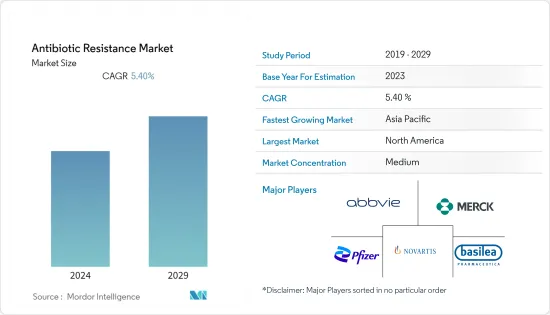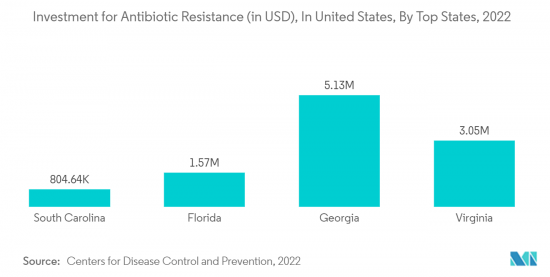
|
市場調査レポート
商品コード
1408498
抗生物質耐性-市場シェア分析、産業動向・統計、2024~2029年成長予測Antibiotic Resistance - Market Share Analysis, Industry Trends & Statistics, Growth Forecasts 2024 - 2029 |
||||||
カスタマイズ可能
適宜更新あり
|
|||||||
| 抗生物質耐性-市場シェア分析、産業動向・統計、2024~2029年成長予測 |
|
出版日: 2024年01月04日
発行: Mordor Intelligence
ページ情報: 英文 111 Pages
納期: 2~3営業日
|
全表示
- 概要
- 目次
抗生物質耐性市場は、基準年に85億米ドルと評価され、予測期間のCAGRは5.4を記録し、105億米ドルになると予想されています。
COVID-19パンデミックは抗生物質耐性市場に影響を与えました。汎米保健機構が2022年3月に発表した記事によると、COVID-19パンデミックは、COVID-19患者を治療するための抗生物質の使用量の増加により、現在進行中の抗菌薬耐性(AMR)の世界的危機に拍車をかけた。さらに、圧倒的な医療システムにおける感染予防と管理の慣行が混乱し、AMRの脅威の監視と対応から人的・財政的資源が流用されました。そのため、パンデミック期間中、市場は高い伸びを示しました。しかし、米国国立医学図書館が2023年3月に発表した研究によると、米国疾病対策予防センターからの新たなデータは、パンデミックによって、カルバペネム耐性アシネトバクターや広域βラクタマーゼ産生腸内細菌を含むAMRの割合が上昇したことを示唆しています。従って、パンデミック後も高い成長が観察されると予想されます。
先進国と新興国市場全体で抗生物質耐性感染症の負担が増加していること、処方パターンが新しく発売された治療薬にシフトしていることが市場の促進要因となっています。さらに、新規治療法の開発における政府と非政府機関の関与の増加が、市場の成長を促進すると予想されます。抗生物質耐性感染症が世界的に大きな問題となっています。例えば、2022年10月に発表されたCDCのデータによると、米国では毎年280万人以上の抗菌薬耐性感染症が発生しています。3万5,000人以上が抗生物質耐性の結果として死亡しています。
さらに2023年2月、オーストラリア政府は、抗菌薬耐性と病院感染の発生率低減に関する調査のために600万米ドルの資金を調達しました。この助成金は、世界のヘルス・イニシアチブの下、医学研究未来基金(MRFF)の一環として発表されました。このように、政府によるこのようなイニシアチブは、予測期間中の市場の成長を後押しすると予想されます。
AMRの分野で事業を展開する大手企業の中には、市場での地位を強化するために、さまざまな新製品の発売とともに、提携や買収などいくつかの戦略を採用しているところもあります。例えば、2023年1月、Alkem Laboratoriesは多剤耐性(MDR)感染症用の抗生物質Zidaviを発売しました。さらに2023年1月、Molbio Diagnosticsは、感染症(MDR-TB)結核菌のイソニアジド耐性の有無を検査するTruenat MTB-INHを発売しました。この検査はICMRによって検証され、CDSCOによって承認されています。
しかし、厳格な安全ガイドラインとAMR治療薬の高コストが市場成長の妨げになると予想されます。
抗生物質耐性市場の動向
複雑性尿路結石セグメントが市場の主要シェアを占める見込み
薬剤耐性菌の増加と抗生物質の過剰使用により、複雑性尿路結石の流行が市場で大きなシェアを占めると予想されます。複雑性尿路感染症とは、単純性尿路感染症以外の尿路感染症のことです。したがって、免疫不全患者、男性、発熱、結石、敗血症、尿閉塞、カテーテル、腎臓を伴う尿路感染症はすべて複雑性尿路感染症とみなされます。
2023年5月にNational Library of Medicineに発表された研究によると、尿路結石に関連する罹患率と死亡率は、全世界で年間1億5,000万症例に上ることが示されています。さらに、2021年2月に発表された研究によると、cUTIで入院した患者の8人に1人にトリプル耐性が発生しています。全体として、複雑性尿路結石の負担は、主に尿路結石症例における耐性菌の増加と再発率の上昇に起因して、予測期間中に増加すると考えられています。

2021年10月、Spero Therapeutics Inc.は米国食品医薬品局(FDA)に新薬承認申請(NDA)を提出し、感受性微生物による腎盂腎炎を含む複雑性尿路感染症(cUTI)の治療薬としてテビペネムHBr錠の承認を求めました。
そのため、複雑性尿路感染症の負担の増加や複雑性尿路感染症治療のためのパイプラインの増加といった要因から、同分野は今後大きな成長を遂げることが予想されます。

予測期間中、北米が大きな市場シェアを占めるだろう
予測期間中、北米が抗生物質耐性市場を独占すると予想されます。この地域の市場は、抗生物質に対する耐性人口の多さ、抗生物質の消費量の多さ、研究開発資金の増加により成長しています。
同地域における抗生物質耐性の負担の増加は、その治療に対する需要を増加させると予想され、予測期間中の市場の成長を後押しすると期待されています。例えば、2022年11月にGlobal Newsに掲載された記事によると、カナダでは、発生する感染症の約26%が第一選択の抗生物質に対して耐性です。耐性は今後指数関数的に増加し、2050年までに第一選択抗生物質と抗真菌薬に対する耐性は40%から100%になると予想されています。このように、国内における抗生物質耐性の負担増が、予測期間中の抗生物質耐性市場の成長を促進すると予想されます。
さらに、AMRプロジェクトに対する資金提供や賞の増加は、この地域における市場の成長を後押しすると予想されます。例えば、2021年12月、CDCはGlobal Action in Healthcare Network(GAIHN)とGlobal Antimicrobial Resistance(AR)Laboratory and Response Networkを設立し、50カ国以上の28団体に2,200万米ドルを授与しました。これらのネットワークは、医療環境における薬剤耐性感染の予防と拡大抑制、地域社会や環境における新たな耐性菌の検出と理解のための検査能力の構築、耐性病原体をより迅速に特定し対応するための手法の開発に重点を置く。したがって、このような取り組みが予測期間中の市場の成長を後押しすると予想されます。
従って、上記の要因により、北米地域での市場成長が期待されます。
抗生物質耐性産業概要
抗生物質耐性市場は緩やかに統合されています。様々な公的機関や民間機関の技術革新や投資の増加により、世界的に業界の競争が激化することが予想されます。また、各社は自社製品を開発・販売促進するために他企業と協力し、市場での認知度を高めています。調査対象市場の主要企業は、AbbVie、Merck &Co.Inc.、Pfizer Inc.、Novartis AG、Basilea Pharmaceutica Ltd.などです。
その他の特典
- エクセル形式の市場予測(ME)シート
- 3ヶ月間のアナリストサポート
目次
第1章 イントロダクション
- 調査の前提条件と市場定義
- 調査範囲
第2章 調査手法
第3章 エグゼクティブサマリー
第4章 市場力学
- 市場概要
- 市場促進要因
- 抗生物質耐性感染症の高い負担
- 世界のイニシアチブの増加が新薬開発を促進
- 市場抑制要因
- 厳格な安全性ガイドライン
- AMR治療薬の高コスト
- ポーターのファイブフォース分析
- 買い手/消費者の交渉力
- 供給企業の交渉力
- 新規参入業者の脅威
- 代替品の脅威
- 競争企業間の敵対関係の強さ
第5章 市場セグメンテーション(市場規模-米ドル)
- 疾患別
- クロストリジウム・ディフィシル感染症(CDI)
- 複雑性腹腔内感染症(cIAI)
- 急性細菌性皮膚・皮膚構造感染症(ABSSSI)
- 院内感染と人工呼吸器関連細菌性肺炎(HABP)
- 合併症性尿路感染症(cUTI)
- 市中肺炎(CABP)
- 血流感染(BSI)
- 病原体別
- アシネトバクター・バウマンニ
- 黄色ブドウ球菌
- 緑膿菌
- インフルエンザ菌
- 大腸菌
- その他の病原体
- 薬剤クラス別
- テトラサイクリン系
- オキサゾリジノン系
- セファロスポリン系
- リポグリコペプチド
- 配合剤
- その他の薬剤クラス別
- 作用機序別
- 細胞壁合成阻害剤
- タンパク質合成阻害剤
- DNA合成阻害剤
- RNA合成阻害剤
- その他の作用機序
- 流通チャネル別
- 病院薬局
- 小売薬局
- オンライン薬局
- 地域別
- 北米
- 米国
- カナダ
- メキシコ
- 欧州
- ドイツ
- 英国
- フランス
- イタリア
- スペイン
- その他の欧州
- アジア太平洋
- 中国
- 日本
- インド
- オーストラリア
- 韓国
- その他のアジア太平洋
- 中東・アフリカ
- GCC諸国
- 南アフリカ
- その他の中東・アフリカ
- 南米
- ブラジル
- アルゼンチン
- その他の南米
- 北米
第6章 競合情勢
- 企業プロファイル
- AbbVie
- Merck & Co. Inc.
- Pfizer Inc
- Novartis AG
- Basilea Pharmaceutica Ltd.
- MELINTA THERAPEUTICS
- Theravance Biopharma
- WOCKHARDT
- Entasis therapeutics
- Paratek Pharmaceuticals, Inc.
- Seres Therapeutics
第7章 市場機会と今後の動向

The antibiotic resistance market was valued at USD 8.5 billion in the base year and is expected to be valued at USD 10.5 billion, registering a CAGR of 5.4 over the forecast period.
The COVID-19 pandemic had an impact on the antibiotic resistance market. As per an article published in March 2022 by the Pan American Health Organization, the COVID-19 pandemic fueled the ongoing antimicrobial resistance (AMR) global crisis due to the increase in the use of antibiotics to treat COVID-19 patients. Moreover, disruptions to infection prevention and control practices in overwhelmed health systems and diversion of human and financial resources away from monitoring and responding to AMR threats. Therefore, the market witnessed high growth during the pandemic. However, as per the study published in March 2023 by the National Library of Medicine, emerging data from the United States Centers for Disease Control and Prevention suggests the pandemic has resulted in rising rates of AMR, including carbapenem-resistant Acinetobacter and extended-spectrum beta-lactamase-producing Enterobacterales. Therefore, it is expected to observe high growth after the pandemic.
The increasing burden of antibiotic-resistant infections across developed & developing regions and a shift in prescription patterns to newly launched therapies are the key drivers of the market. Moreover, the increasing involvement of Government and non-government bodies in developing novel therapies is anticipated to drive market growth. The high burden of antibiotic-resistant infections is a major concern globally. For instance, as per the CDC's data published in October 2022, in the United States, more than 2.8 million antimicrobial-resistant infections occur each year. More than 35,000 people die as a result of antibiotic resistance.
Moreover, in February 2023, the Australian Government raised USD 6 million in funds for research into antimicrobial resistance and reducing the incidence of hospital infections. This grant opportunity was announced as part of the Medical Research Future Fund (MRFF) under the Global Health Initiative. Thus, such initiatives taken by the Government are expected to boost the market's growth over the forecast period.
Some major companies operating in the AMR are adopting several strategies, such as collaboration and acquisition, along with various launches to strengthen their positions in the market. For instance, in January 2023, Alkem Laboratories launched an antibiotic, Zidavi, for multiple drug-resistant (MDR) infections. Moreover, in January 2023, Molbio Diagnostics launched Truenat MTB-INH for testing the presence of isoniazid resistance in Mycobacterium tuberculosis in infection (MDR-TB). The test is validated by ICMR and approved by CDSCO, which can provide sample-to-test results in an hour.
However, strict safety guidelines and the high cost of AMR therapeutics are expected to hinder the market's growth.
Antibiotic Resistance Market Trends
Complicated UTIs Segment Expected to Hold a Major Share in the Market
The prevalence of complicated UTIs is expected to hold a major share in the market, owing to the rise in drug-resistant bacteria and excessive use of antibiotics. A complicated UTI is any urinary tract infection other than a simple UTI. Therefore, all urinary tract infections in immunocompromised patients, males, and those associated with fevers, stones, sepsis, urinary obstruction, catheters, or involving the kidneys are considered complicated infections.
As per the study published in May 2023 in the National Library of Medicine, morbidity and mortality associated with UTI were shown to be 150 million cases globally per year. Moreover, per the study published in February 2021, triple resistance occurs in 1 in 8 patients hospitalized with cUTI. Overall, the burden of complicated UTIs is set to increase during the forecast period, mainly owing to the increasing bacterial resistance in UTI cases and the rise in the recurrence rate.
In October 2021, Spero Therapeutics Inc. submitted a new drug application (NDA) to the US Food and Drug Administration (FDA), seeking approval for tebipenem HBr tablets for the treatment of complicated urinary tract infections (cUTI), including pyelonephritis, caused by susceptible microorganisms.
Therefore, owing to factors such as the rising burden of complicated UTIs and increasing pipeline activities to treat complicated UTIs, the segment is expected to witness significant growth in the future.

North America Would Hold a Significant Market Share Over the Forecast Period
North America is expected to dominate the antibiotic resistance market over the forecast period. The market is growing in the region due to the high population resistant to antibiotics, high consumption of antibiotics, and increasing funding for research and development.
The increasing burden of antibiotic resistance in the region is expected to increase the demand for its therapy, which is expected to boost the market's growth over the forecast period. For instance, as per an article published in Global News in November 2022, in Canada, about 26% of infections that occur are resistant to first-line antibiotics. Resistance is expected to grow exponentially in the coming years, from 40% to 100% resistance to first-line antibiotics and antifungals by 2050. Thus, the increasing burden of antibiotic resistance in the country is expected to drive the growth of the antibiotic resistance market over the forecast period.
Moreover, increased funding and awards for AMR projects are expected to boost the market's growth in the region. For instance, in December 2021, the CDC awarded USD 22 million to 28 organizations in more than 50 countries by establishing the Global Action in Healthcare Network (GAIHN) and the Global Antimicrobial Resistance (AR) Laboratory and Response Network. The networks will focus on preventing and limiting the spread of drug-resistant infections in healthcare settings, building laboratory capacity to detect and understand emerging resistant organisms in the community and the environment, and developing methods to identify and respond to resistant pathogens more quickly. Thus, such initiatives are expected to boost the market's growth over the forecast period.
Therefore, the studied market growth is anticipated in the North American region due to the factors above.
Antibiotic Resistance Industry Overview
The antibiotic resistance market is moderately consolidated. Increased innovation and investment for various public and private organizations are expected to intensify industry rivalry worldwide. They are also collaborating with other players to develop and promote their products and thus gain recognition in the market. The major players in the studied market are AbbVie, Merck & Co. Inc., Pfizer Inc., Novartis AG, Basilea Pharmaceutica Ltd., and others.
Additional Benefits:
- The market estimate (ME) sheet in Excel format
- 3 months of analyst support
TABLE OF CONTENTS
1 INTRODUCTION
- 1.1 Study Assumptions and Market Definition
- 1.2 Scope of the Study
2 RESEARCH METHODOLOGY
3 EXECUTIVE SUMMARY
4 MARKET DYNAMICS
- 4.1 Market Overview
- 4.2 Market Drivers
- 4.2.1 High Burden of Antibiotic Resistant Infections
- 4.2.2 Increase in Global Initiatives Drives New Drug Development
- 4.3 Market Restraints
- 4.3.1 Strict Safety Guidelines
- 4.3.2 High Cost of AMR Therapeutics
- 4.4 Porter's Five Forces Analysis
- 4.4.1 Bargaining Power of Buyers/Consumers
- 4.4.2 Bargaining Power of Suppliers
- 4.4.3 Threat of New Entrants
- 4.4.4 Threat of Substitute Products
- 4.4.5 Intensity of Competitive Rivalry
5 MARKET SEGMENTATION (Market Size by Value - USD)
- 5.1 By Disease
- 5.1.1 Clostridioides Difficile Infection (CDI)
- 5.1.2 Complicated Intra-Abdominal Infection (cIAI)
- 5.1.3 Acute Bacterial Skin and Skin Structure Infections (ABSSSI)
- 5.1.4 Hospital-Acquired and Ventilator-Associated Bacterial Pneumonias (HABP)
- 5.1.5 Complicated Urinary Tract Infection (cUTI)
- 5.1.6 Community-Acquired Pneumonia (CABP)
- 5.1.7 Bloodstream Infection (BSI)
- 5.2 By Pathogen
- 5.2.1 Acinetobacter baumannii
- 5.2.2 Staphylococcus aureus
- 5.2.3 Pseudomonas aeruginosa
- 5.2.4 Haemophilus influenzae
- 5.2.5 E. Coli
- 5.2.6 Other Pathogens
- 5.3 By Drug Class
- 5.3.1 Tetracyclines
- 5.3.2 Oxazolidinones
- 5.3.3 Cephalosporins
- 5.3.4 Lipoglycopeptides
- 5.3.5 Combination therpaies
- 5.3.6 Other Drug Classes
- 5.4 By Mechanism of Action
- 5.4.1 Cell Wall Synthesis Inhibitors
- 5.4.2 Protein Synthesis Inhibitors
- 5.4.3 DNA Synthesis Inhibitors
- 5.4.4 RNA synthesis inhibitors
- 5.4.5 Other Mechanisms of Action
- 5.5 By Distribution Channel
- 5.5.1 Hospital Pharmacies
- 5.5.2 Retail Pharmacies
- 5.5.3 Online Pharmacies
- 5.6 Geography
- 5.6.1 North America
- 5.6.1.1 United States
- 5.6.1.2 Canada
- 5.6.1.3 Mexico
- 5.6.2 Europe
- 5.6.2.1 Germany
- 5.6.2.2 United Kingdom
- 5.6.2.3 France
- 5.6.2.4 Italy
- 5.6.2.5 Spain
- 5.6.2.6 Rest of Europe
- 5.6.3 Asia-Pacific
- 5.6.3.1 China
- 5.6.3.2 Japan
- 5.6.3.3 India
- 5.6.3.4 Australia
- 5.6.3.5 South Korea
- 5.6.3.6 Rest of Asia-Pacific
- 5.6.4 Middle East and Africa
- 5.6.4.1 GCC
- 5.6.4.2 South Africa
- 5.6.4.3 Rest of Middle East and Africa
- 5.6.5 South America
- 5.6.5.1 Brazil
- 5.6.5.2 Argentina
- 5.6.5.3 Rest of South America
- 5.6.1 North America
6 COMPETITIVE LANDSCAPE
- 6.1 Company Profiles
- 6.1.1 AbbVie
- 6.1.2 Merck & Co. Inc.
- 6.1.3 Pfizer Inc
- 6.1.4 Novartis AG
- 6.1.5 Basilea Pharmaceutica Ltd.
- 6.1.6 MELINTA THERAPEUTICS
- 6.1.7 Theravance Biopharma
- 6.1.8 WOCKHARDT
- 6.1.9 Entasis therapeutics
- 6.1.10 Paratek Pharmaceuticals, Inc.
- 6.1.11 Seres Therapeutics


